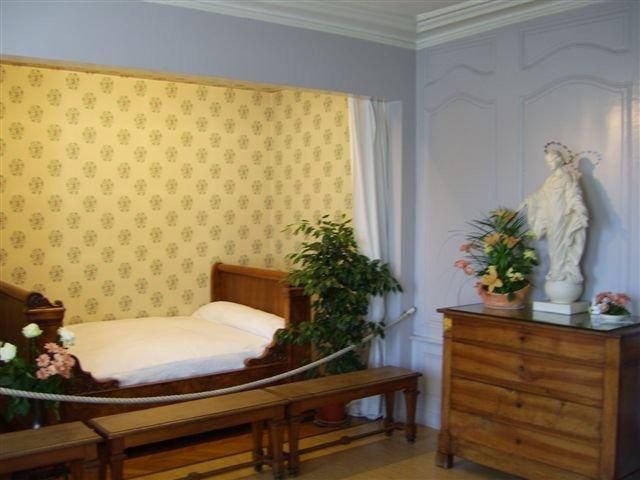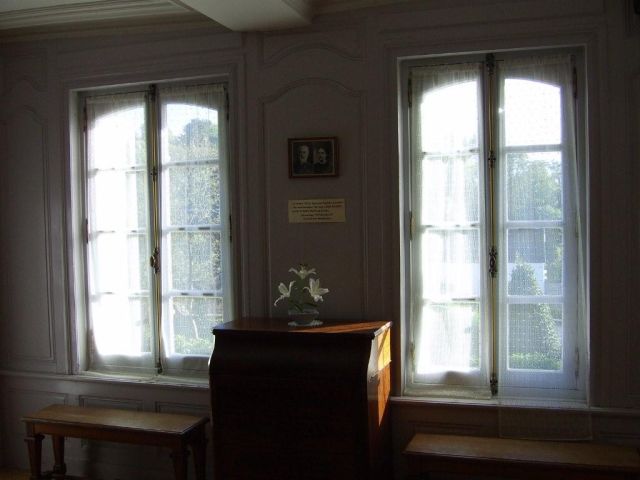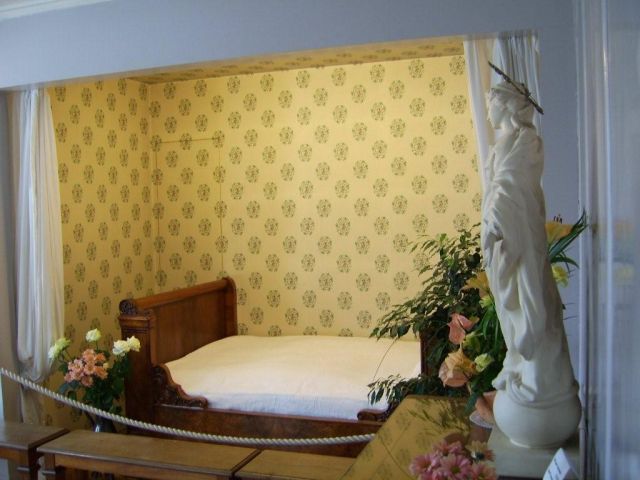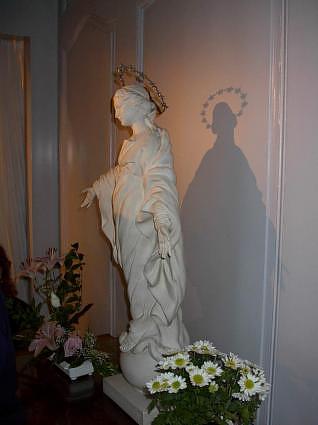Therese Is Cured at Age Ten
Through the Intercession of the Blessed Virgin
During the Easter vacation in 1883, when Therese was ten years old, she was attacked by a mysterious illness. Her symptoms included trembling and frequent hallucinations. She could not be left alone, and her doctor was baffled.1 Her father began to be afraid that she was going to die.
 The bedroom at Les Buissonnets where Therese was cured while praying to the Blessed Virgin
The bedroom at Les Buissonnets where Therese was cured while praying to the Blessed Virgin
As Therese recounts, her father gave Marie some gold pieces and asked her to write to the shrine of Notre-Dame-des-Victoires in Paris,2 a place of renewal for the French church and a sanctuary dear to him and to Zelie, to ask for a novena of Masses to be offered for Therese's cure.

Windows of the bedroom in Les Buissonnets where Therese was cured through the prayers of the Blessed Virgin
Therese's healing on May 13, 1883
During this novena of Masses, on Pentecost Sunday, May 13, 1883, Therese was suddenly cured. Marie had gone out into the garden, leaving Therese with Leonie, who was reading near the window. Therese began to call for "Maman," meaning Marie. But when Marie came back into the room, Therese did not recognize her; she was in the midst of the worst attack of her whole illness. Marie testified that she wanted to give Therese something to drink, but Therese "screamed in terror: 'They want to poison me." Marie knelt by the bed with Celine and Leonie, praying fervently before the statue they later called the "Virgin of the Smile."3 Therese, from the bed, also turned toward the statue and prayed fervently. Suddenly Marie saw Therese's face grow calm and her eyes clear. She understood that Therese had seen the Blessed Virgin herself. The vision lasted four or five minutes. Therese described it:
 Bed in the chamber at Les Buissonnets where Therese was cured through the Blessed Virgin's prayers
Bed in the chamber at Les Buissonnets where Therese was cured through the Blessed Virgin's prayers
All of a sudden the Blessed Virgin appeared beautiful to me, so beautiful that never had I seen anything so attractive; her face was suffused with an ineffable benevolence and tenderness, but what penetrated to the very depths of my soul was the ravishing smile of the Blessed Virgin.
 A replica of the statue of the "Virgin of the Smile" at Les Buissonnets. The actual statue Therese knew now stands above her tomb in the chapel of the Lisieux Carmel.
A replica of the statue of the "Virgin of the Smile" at Les Buissonnets. The actual statue Therese knew now stands above her tomb in the chapel of the Lisieux Carmel.
A reflection by Sister Constance FitzGerald:
In her paper “Mission: Saigon and Beyond,” Sister Constance FitzGerald interprets this healing:
Having been ‘rejected’ by or separated from Pauline, who ‘takes the veil,’ Therese cannot help wanting to disappear, to die, to refuse to be a self or to mother herself. Now the veil shrouds Therese; she refises the face, she refuses incarnation. She withdraws from the family, from extreme fear and pain, into illness and depression. She almost dies from accumulated mother-losses while all the time crying out for “Mamma” in her delirium.
The miracle is that when everything seems blocked, an eternal regard breaks through the aperture, enabling little Therese to find enough inner strength to lift the veil and look into the mirror. She surpasses the protective confines of her relationship with Pauline and reaches out from the tiny core of her selfhood, from the depths of her battered psyche, through the opening on eternity, to be mothered by the infinite abyss, by a transcendent Mother-face suffused with absolute esteem: the smiling gaze of the Blessed Virgin giving her back the totality of her being.
Mary is the beginning of the ‘Mamma’ God. She is the window on the maternal side of God, another opening on eternity. It is no accident the Blessed Virgin Mother appears. For Therese the aspect of Jesus as Mother is not available in her theological lexicon, so she displaces the mother-face on to Mary. She does not know Jesus is mother; we know, however, because of the language she uses. The marvel is that not only her conscious self (choosing Carmel for Jesus’ sake), but even her hidden depths, far below the strata of thoughts and words, finally reach through the widening aperture on eternity for the mother-bond, the mother-face, giving rise to Mother-Jesus who appears in one transcendent moment as the Christ-face and in another transcendent moment as Mary’s face. Both are examples of Mother-God faces.
Notes:
1. See the details of Therese's illness on the Web site of the Archives of the Carmel of Lisieux:
- Therese's narrative and her sister Marie's memories
- "A Strange illness: the illness of Therese at age ten from Easter to Pentecost 1883," by Dr. Marie-Dominique Fouqueray, psychiatrist
- "To know more" - further reading about the diagnosis
2. Notre-Dame des Victoires is now a basilica. You can visit it in Paris and recall Therese's visit to Notre-Dame-des-Victoires in November 1887 when she was setting out on the pilgrimage to Rome. On the Web site of the Archives of the Carmel of Lisieux, read Therese's account of the unique Marian grace she received then).
3. Read the history of the statue of Our Lady of the Smile and its place in the life of the Martin family at Alencon.
